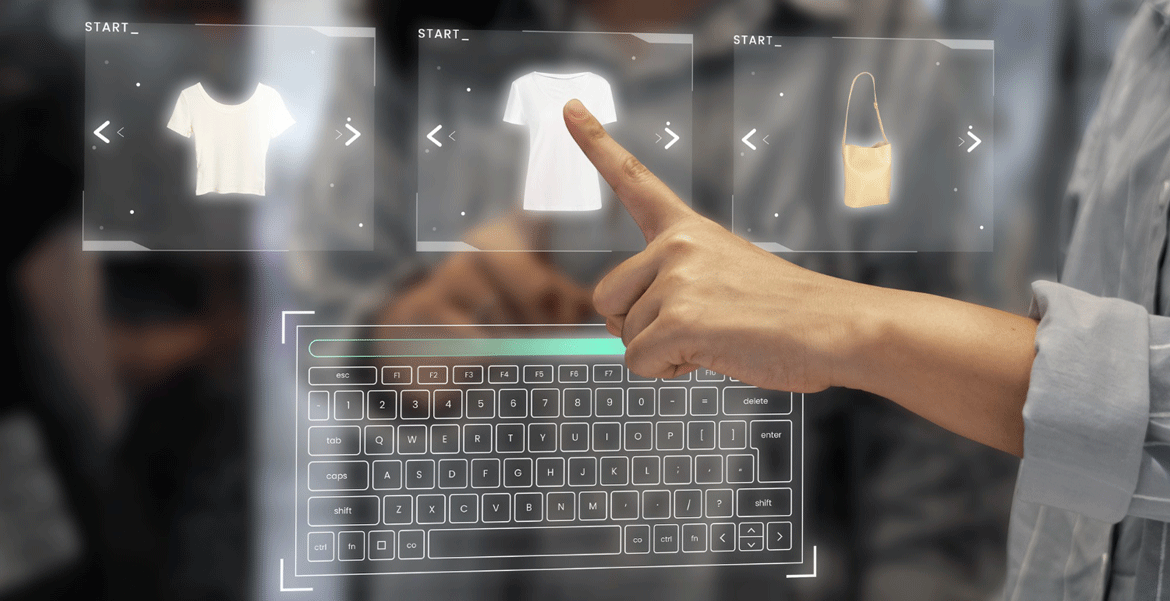E-commerce has evolved from a novel convenience to an integral component of global commerce, with its trajectory shaped by rapid technological advancements and shifting consumer behaviors.
The industry is characterized by a dynamic and ever-changing landscape, which requires businesses to stay agile and proactive in embracing new trends. In this article, we’ll delve into key e-commerce trends expected for 2024, offering insights and strategies to help your business not only navigate but thrive in the evolving e-commerce arena.
Table of Contents
- Trend #1. Augmented Reality (AR) Shopping Experiences
- Trend #2. Integration of Social Commerce
- Trend #3. Voice Commerce
- Trend #4. Same-Day and Instant Delivery
- Trend #5. Subscription-Based Models
Trend #1. Augmented Reality (AR) Shopping Experiences

In 2024, the integration of augmented reality (AR) into e-commerce platforms is poised to elevate the online shopping experience in profound ways. AR technologies are set to transform how consumers interact with products, fostering a more immersive and personalized connection. One significant aspect of this transformation lies in the application of AR for virtual try-ons.
AR-powered virtual try-ons will redefine the way users engage with products, particularly in the realms of fashion, accessories, and beauty. Through the lens of AR, users will be able to virtually try on clothing, accessories, and makeup in real-time. This technology leverages advanced computer vision and image recognition to overlay virtual representations of products onto the user’s physical environment.
By virtually trying on products, customers can make more informed decisions about fit, style, and appearance before committing to a purchase. This addresses a longstanding challenge in online shopping, where the inability to physically interact with products often leads to uncertainty. Also with virtual tools, users can visualize how products look individually on them based on their unique body shape, skin tone or facial features. This level of personalization fosters a stronger emotional connection between the consumer and the product.
Integration of AR technologies transcends the limitations of traditional online shopping by providing a dynamic and interactive experience that closely simulates the in-store try-on process. This not only meets the growing expectations of consumers but positions e-commerce businesses at the forefront of technological innovation in 2024.
Trend #2. Integration of Social Commerce
Social commerce has evolved into a dominant force in e-commerce, with platforms like Instagram, Facebook, and TikTok transforming into seamless shopping hubs. In 2024, businesses can leverage these platforms to reach and engage customers directly within the app, providing unparalleled convenience.
The rise of social commerce in 2024 presents unprecedented opportunities for businesses to connect with customers and facilitate transactions seamlessly. Social platforms have integrated shopping features, allowing users to make purchases without leaving the app. To maximize this trend, businesses should cultivate a strong social media presence – сraft a content strategy that incorporates product showcases, compelling videos, and collaborations with influencers to enhance visibility. Engaging with your audience through prompt responses to comments and messages builds trust and fosters a sense of community.
Furthermore, utilizing social media advertising expands your reach and promotes products effectively. By embracing social commerce, businesses can tap into an expansive pool of potential customers, driving revenue and amplifying e-commerce sales.
Trend #3. Voice Commerce

In 2024, the impact of voice-activated devices, equipped with intelligent voice assistants such as Siri, Alexa, and Google Assistant, is reshaping the way consumers interact with online shopping platforms. The integration of voice technology introduces a seamless and convenient dimension to the e-commerce experience.
Voice-activated devices, ranging from smart speakers to smartphones, have become ubiquitous in households, offering users hands-free access to information and services. In the realm of e-commerce, these devices serve as virtual shopping assistants, allowing customers to navigate, explore, and make purchases using voice commands. This shift towards voice commerce streamlines the online shopping process, offering a more natural and intuitive interface for users.
Businesses embracing voice commerce can optimize their platforms to align with the preferences of a voice-activated audience. Voice assistants facilitate tasks such as product searches, order placements, and even personalized recommendations. The integration of voice technology also opens avenues for businesses to provide tailored and user-friendly experiences.
Trend #4. Same-Day and Instant Delivery
Same-day and instant delivery services aim to provide customers with unparalleled convenience, reducing the waiting time between placing an order and receiving the purchased items. This evolution in delivery services is driven by the consumer’s desire for immediacy, a trend fueled by the influence of major e-commerce players and heightened expectations set by various industries.
E-commerce platforms are now strategically partnering with local logistics providers, employing advanced route optimization algorithms, and establishing fulfillment centers in key locations to enable same-day and instant delivery. This shift not only caters to the demand for rapid order fulfillment but also enhances customer satisfaction and loyalty.
In 2024, businesses that prioritize and successfully implement these expedited delivery options are better positioned to meet the dynamic needs of modern consumers, setting a new standard for the e-commerce experience.
Trend #5. Subscription-Based Models

The subscription e-commerce market is still experiencing significant growth. According to a report by McKinsey, the subscription e-commerce market has grown by over 100% annually for the past five years. In 2024, businesses will increasingly adopt subscription models, and this shift is reshaping the traditional way consumers engage with products and services. This model is characterized by customers subscribing to receive goods or services on a regular basis, whether monthly, quarterly, or annually.
For businesses, the adoption of subscription-based models brings a plethora of advantages. The predictable nature of recurring revenue from subscriptions provides a stable financial foundation, offering businesses a clearer and more sustainable revenue stream. This steady income allows for better financial planning, investment in product innovation, and overall business growth.
On the consumer front, the appeal of subscription-based models lies in the convenience, customization, and cost-effectiveness they offer. Subscribers often benefit from discounted rates, exclusive access to new products or features, and the convenience of automated deliveries. This not only enhances customer loyalty but also fosters a long-term relationship between businesses and their clientele.
Moreover, subscription models create a sense of community and engagement. Consumers feel like part of an exclusive club, enjoying a personalized and curated experience that aligns with their preferences. As the subscription-based e-commerce trend continues to gain momentum, businesses that successfully leverage this model stand to cultivate a loyal customer base and achieve sustained success in the evolving market landscape of 2024.



![Is WordPress Good for E-commerce? [Pros & Cons]](https://itcreativelabs.com/wp-content/uploads/2024/03/is-wordpress-good-for-e-commerce-1024x525.png)


